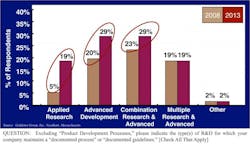Applied Research & Advanced Development Processes Come of Age
This growth in predevelopment activity is likely a manifestation of Western companies trying to improve their ability to innovate. It also likely results from years of self-inflicted corporate pain when companies try to bring innovative products to market quickly — having to set product-release dates despite being unable to accurately predict how long development would take. Finally, the lean and Six Sigma movements of the past two decades have helped companies execute but have made innovation in product development more difficult.
Regardless of the reason, predevelopment processes are a step forward in the management science that companies use. Innovation typically requires some type of divergence. Product-development processes, however, are convergent in nature. Dedicated corporate functions and processes that enable divergence for innovation purposes are long overdue.
This corporate “experiment” of the past 12 years with preproduct development has evidently worked fairly well. Taking “schedule busters” out of product development is now preferred. How do we know? Well, it is almost an unwritten rule that within companies, the creation infrastructure in companies for activities lags creation of the activities themselves. If an activity does not bear fruit, its infrastructure is typically never built. Corporations are moving aggressively to create infrastructure — processes and guidelines — that addresses the specific needs of “not-ready-to-schedule” technologies and capabilities. Growth in these infrastructures over the past five years has been significant.
During the past five years, there has been a near-quadrupling of applied-research processes and a 50% increase in advanced-development processes. In addition, the number of generalized preproduct-development processes has risen by 25%. These generalized processes are flexible enough to handle projects in both applied research and advanced development. Three-quarters of all companies have preproduct-development activities, and 85 to 90% of those companies also have one or more documented processes or guidelines to organize and facilitate those activities. The rest of the companies wanting innovation in their portfolio that customers or markets can recognize will soon follow. Companies offering process-management software for product development will be adding modules that address preproduct-development activities. Metrics and measures for these processes will come next. Industry leaders have already begun the measurement process.
As time goes on, product development will increasingly become execution oriented. If you personally seek more creativity challenges than execution challenges, you may wish to see if you can move upstream. Innovation will always be inherent in product development, but breakthroughs and disruptive innovations will likely be found in emerging applied research and advanced development organizations in the years ahead.
About the Author
Bradford Goldense
Contributing Technical Expert
Bradford L. Goldense is founder and president of Goldense Group, Inc. [GGI] (www.goldensegroupinc.com), a consulting, market research, and education firm focused on business and technology management strategies and practices for product creation, development, and commercialization. He has been an adjunct faculty member of the graduate engineering school at Tufts University's Gordon Institute for 19 years. Goldense is a Certified New Product Development Professional [NPDP], a Certified Manufacturing Engineer [CMfgE], a Certified Computer Professional [CCP], and is Certified In Production & Inventory Management [CPIM]. He holds over 200 registered copyrights and is a recognized subject-matter expert, including appearances on PBS and CNBC. He has consulted to over 250 companies and over 750 manufacturing locations on four continents since founding GGI in 1986. Goldense holds an MBA in Accounting from the Cornell Johnson School and a BSCE from Brown University. For more information, please see Brad's LinkedIn profile or visit GGI's home page.


